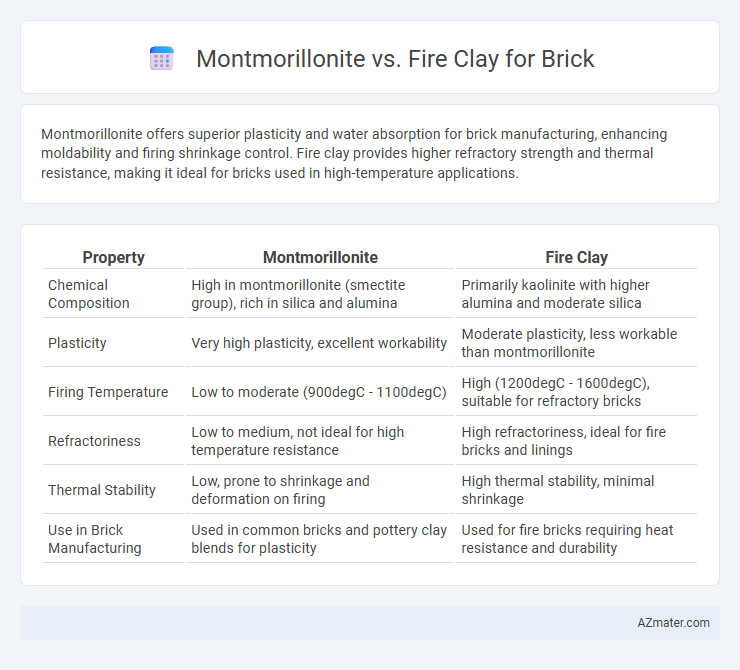Montmorillonite offers superior plasticity and water absorption for brick manufacturing, enhancing moldability and firing shrinkage control. Fire clay provides higher refractory strength and thermal resistance, making it ideal for bricks used in high-temperature applications.
Table of Comparison
| Property | Montmorillonite | Fire Clay |
|---|---|---|
| Chemical Composition | High in montmorillonite (smectite group), rich in silica and alumina | Primarily kaolinite with higher alumina and moderate silica |
| Plasticity | Very high plasticity, excellent workability | Moderate plasticity, less workable than montmorillonite |
| Firing Temperature | Low to moderate (900degC - 1100degC) | High (1200degC - 1600degC), suitable for refractory bricks |
| Refractoriness | Low to medium, not ideal for high temperature resistance | High refractoriness, ideal for fire bricks and linings |
| Thermal Stability | Low, prone to shrinkage and deformation on firing | High thermal stability, minimal shrinkage |
| Use in Brick Manufacturing | Used in common bricks and pottery clay blends for plasticity | Used for fire bricks requiring heat resistance and durability |
Introduction to Brick-Making Materials
Montmorillonite and fire clay are essential raw materials in brick-making, each offering unique properties that influence the final brick quality. Montmorillonite, a highly plastic clay mineral, enhances the workability and strength of bricks by improving water retention and shrinkage control. Fire clay, known for its high refractory properties and heat resistance, contributes to bricks that can withstand high temperatures, making it ideal for industrial and furnace applications.
What is Montmorillonite Clay?
Montmorillonite clay is a highly absorbent, fine-grained mineral known for its swelling properties when exposed to moisture, making it crucial in brick manufacturing for enhancing plasticity and strength. Fire clay, in comparison, contains less montmorillonite but offers higher resistance to heat due to its iron and alumina content, ideal for refractory bricks used in high-temperature environments. The presence of montmorillonite improves the workability and durability of bricks, whereas fire clay ensures thermal stability and structural integrity under extreme heat conditions.
What is Fire Clay?
Fire clay is a refractory material known for its high alumina content, typically sourced from sedimentary clay deposits. It exhibits exceptional heat resistance and thermal stability, making it ideal for manufacturing fire bricks used in kilns, furnaces, and fireplaces. Compared to montmorillonite, which has high swelling properties and plasticity, fire clay offers superior durability and resistance to thermal shock in brick production.
Chemical Composition Comparison
Montmorillonite primarily consists of hydrated sodium calcium aluminum magnesium silicate with a high content of silica (SiO2) and alumina (Al2O3), which contributes to its excellent plasticity and binding properties in brick manufacturing. Fire clay, on the other hand, contains a higher proportion of kaolinite (Al2Si2O5(OH)4) with significant alumina content and relatively lower silica, providing superior refractory qualities and higher thermal stability in brick applications. The chemical composition difference, specifically the silica-to-alumina ratio and the presence of fluxing agents, critically influences the firing temperature, porosity, and durability of bricks made from these materials.
Physical Properties and Workability
Montmorillonite exhibits high plasticity and water absorption due to its fine particle size and layered crystal structure, enhancing brick workability but increasing shrinkage risks. Fire clay contains higher alumina content with coarser particles, offering better refractory properties and dimensional stability during firing, resulting in lower plasticity but improved durability. The choice impacts molding ease and final brick strength, with montmorillonite favored for shaping flexibility and fire clay for heat resistance.
Thermal Resistance and Behavior under High Temperatures
Montmorillonite bricks exhibit superior thermal resistance due to their fine particle size and ability to withstand rapid temperature fluctuations without cracking. Fire clay bricks demonstrate exceptional behavior under high temperatures, maintaining structural integrity and resisting deformation up to 1600degC due to their high alumina content. The choice between montmorillonite and fire clay hinges on specific thermal requirements, with montmorillonite favored for insulation and fire clay preferred for extreme heat durability.
Durability and Longevity in Bricks
Montmorillonite offers superior plasticity and water retention, enhancing brick moldability, but it can cause excessive shrinkage affecting durability. Fire clay contains higher alumina and lower silica, contributing to exceptional heat resistance and structural strength that improves the longevity of refractory bricks. Bricks made with fire clay typically exhibit greater durability under high-temperature and harsh environmental conditions compared to those with montmorillonite.
Cost and Availability of Montmorillonite vs Fire Clay
Montmorillonite is generally more affordable and widely available compared to fire clay due to its abundant natural deposits, particularly in regions like the United States and India. Fire clay, while offering superior high-temperature resistance for brick manufacturing, tends to be costlier and less readily accessible because of its limited geological distribution. The cost-effectiveness and accessibility of montmorillonite make it a preferred choice for bricks where budget constraints and local material availability are critical factors.
Environmental Impact of Extraction and Use
Montmorillonite extraction often causes less environmental disruption than fire clay due to its typically surface-level deposits, reducing the need for extensive mining operations. Fire clay mining involves deeper excavation, resulting in greater habitat destruction and higher energy consumption during extraction. In brick production, montmorillonite contributes to lower emissions by requiring less intense firing temperatures compared to fire clay, which typically demands higher energy input and releases more pollutants.
Choosing the Right Clay for Brick Manufacturing
Montmorillonite, known for its high plasticity and absorption properties, enhances the workability and durability of bricks but requires careful control of moisture content to prevent excessive shrinkage during firing. Fire clay, with superior refractory qualities and resistance to high temperatures, is ideal for manufacturing bricks that must withstand intense heat, such as firebricks used in kilns and furnaces. Selecting the right clay depends on the specific application and performance requirements, with Montmorillonite favored for general building bricks and Fire clay preferred for heat-resistant construction materials.

Infographic: Montmorillonite vs Fire Clay for Brick
 azmater.com
azmater.com